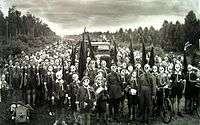Gas mask
A gas mask is a mask used to protect the wearer from inhaling airborne pollutants and toxic gases. The mask forms a sealed cover over the nose and mouth, but may also cover the eyes and other vulnerable soft tissues of the face. Most gas masks are also respirators, though the word gas mask is often used to refer to military equipment (such as a field protective mask), the scope used in this article. The gas mask only protects the user from digesting, inhaling and contact through the eyes (many agents affect through eye contact). Most combined gas mask filters will last around 8 hours in a nuclear biological chemical (NBC) situation. Chemical specific filters can last up to 20 hours in an NBC situation.
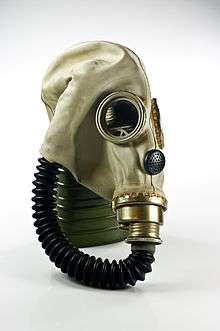
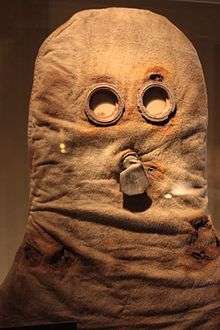
Airborne toxic materials may be gaseous (for example, mustard gas and chlorine gas) or particulates (such as biological agents). Many filters include protection from both types.
The first gas masks mostly used circular lenses made either of glass, mica or cellulose acetate. With the exception of the latter, these materials were quite brittle and needed frequent replacement. Later on, the Triplex lense style (two layers of glass and one layer of cellulose acetate in between)[1] became more popular, and alongside the simpler cellulose acetate they became the standard into the '30s. Panoramic lenses were not popular until the '30s, but there are some examples of those being used even during the war (Austro-Hungarian 15M). Later, polycarbonate started being used for its strength.
Some have one or two filters screwed (via inlets) onto to the gas mask while others have a large filter (coffee can filter) connected to the gas mask with a hose that is sometimes confused with an air-supplied respirator in which an alternate supply of fresh air (oxygen tanks) is delivered.
Principles of construction
Absorption is the process of being drawn into a (usually larger) body or substrate, and adsorption is the process of deposition upon a surface. This can be used to remove both particulate and gaseous hazards. Although some form of reaction may take place, it is not necessary; the method may work by attractive charges. For example, if the target particles are positively charged, a negatively charged substrate may be used. Examples of substrates include activated carbon, and zeolites. This effect can be very simple and highly effective, for example using a damp cloth to cover the mouth and nose while escaping a fire. While this method can be effective at trapping particulates produced by combustion, it does not filter out harmful gases which may be toxic or which displace the oxygen required for survival.
 US Navy MCU-2/P gas mask system.
US Navy MCU-2/P gas mask system. Gas mask used by the French military. The filter cartridge is connected via a flexible hose.
Gas mask used by the French military. The filter cartridge is connected via a flexible hose.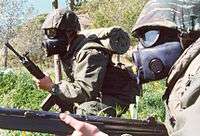 Greek Infantry with US M17 gas masks
Greek Infantry with US M17 gas masks
Safety of old gas masks
Gas masks have a limited useful lifespan that is related to the absorbent capacity of the filter. Once the filter has been saturated with hazardous chemicals, it ceases to provide protection and the user may be injured. Most gas masks use sealing caps over the air intake and are stored in vacuum sealed bags to prevent the filter from degrading before use, but the protective abilities also degrade as the filter ages or if it is exposed to moisture and heat. Very old unused gas mask filters from World War II may not be effective at all in protecting the user, and can even potentially cause harm to the user due to long-term changes in the filter chemical composition.
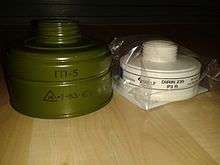
Some World War II gas masks contained chrysotile asbestos or crocidolite asbestos in their filters.[2][3][4] It is unknown how long for certain the materials were used in filters. Breathing blue asbestos in the factories resulted in the death of 10 percent of the workforce due to pleural and peritoneal mesothelioma. This rate was between 2.5 and 3.2 times the normal incidence of lung or respiratory cancers.[5]
Many stories have originated from various Russian gas masks and their filters that are now common in surplus stores; the GP-5 was often considered to have an asbestos filter. Although the filter is made so that the asbestos fibres cannot be breathed in if the filter layer is not damaged, these expired filters and others should be avoided for risk of health. All Russian Cold War period gas mask filters contain asbestos and should be avoided.
Modern gas masks are quite safe and do not use asbestos, but it is still important to be careful when using a modern gas mask. Typically, masks using 40 mm connections are a more recent design. Rubber degrades with time, so new in-box "modern type" masks can be cracked and leak. Also, the US C2 canister (black) was shown to contain hexavalent chromium: the studies by the U.S. Army Chemical Corps showed that the levels in the filter were acceptable, but imply caution when using, as it is a carcinogen.
Filter classification
The filter is selected according to the toxic compound.[6] Each filter type protects against a particular hazard and is color-coded:
| EU Class, color | US color[7] | Hazard |
|---|---|---|
| AX, brown | black | Low-boiling (≤65 °C) organic compounds |
| A, brown | High-boiling (>65 °C) organic compounds | |
| B, grey | (many) | Inorganic gases (hydrogen sulfide, chlorine, hydrogen cyanide) |
| E, yellow | white | Acidic gases (Sulfur dioxide and hydrogen chloride) |
| K, green | green | Ammonia and amines |
| CO, black | blue | Carbon monoxide |
| Hg, red | N/A | Mercury vapor |
| Reactor, orange | magenta | Radioactive (iodine and methyl iodide) |
| P, white | purple, orange, or teal | particles |
Particle filters are often included, because in many cases, the hazardous materials are in the form of mist, which is captured already by the particle filter before entering the chemical adsorber. In Europe and jurisdictions with similar rules like Russia and Australia, filter types are given suffix numbers to indicate their capacity: for non-particle hazards, the level "1" is assumed and a number "2" is used to indicate a better level. For particles (P), three levels are always given with the number.[6] In the US, only the particle part is further classified by NIOSH air filtration ratings.[7]
A filter type that can protect multiple hazards is notated with the European symbols concatenated with each other. Examples include ABEK, ABEK-P3, and ABEK-HgP3.[6] A2B2E2K2-P3 is the highest rating of filter available. An entirely different "multi/CBRN" filter class with an olive color is used in the US.[7]
Filtration may be aided with an air pump to improve wearer comfort. Filtration of air is only possible if there is sufficient oxygen in the first place. Thus, when handling asphyxiants, or when ventilation is poor or the hazards are unknown, filtration is not possible and air must be supplied (with a SCBA system) from a pressurized bottle as in scuba diving.
Use
A modern mask typically is constructed of an elastic polymer in various sizes. It is fitted with various adjustable straps which may be tightened to secure a good fit. Crucially, it is connected to a filter cartridge near the mouth either directly, or via a flexible hose. Some models contain drinking tubes which may be connected to a water bottle. Corrective lens inserts are also available for users who require them.
Masks are typically tested for fit before use. After a mask is fitted, it is often tested by various challenge agents. Isoamyl acetate, a synthetic banana flavourant, and camphor are often used as innocuous challenge agents. In the military, teargases such as CN, CS, and stannic chloride in a chamber may be used to give the users confidence in the efficiency of the mask.[8]
Reaction and exchange
This principle relies on substances harmful to humans being usually more reactive than air. This method of separation will use some form of generally reactive substance (for example an acid) coating or supported by some solid material. An example is synthetic resins. These can be created with different groups of atoms (usually called functional groups) that have different properties. Thus a resin can be tailored to a particular toxic group. When the reactive substance comes in contact with the resin, it will bond to it, removing it from the air stream. It may also exchange with a less harmful substance at this site.
Though it was crude, the hypo helmet was a stopgap measure for British troops in the trenches that offered at least some protection during a gas attack. As the months passed and poison gas was used more often, more sophisticated gas masks were developed and introduced. There are two main difficulties with gas mask design:
- The user may be exposed to many types of toxic material. Military personnel are especially prone to being exposed to a diverse range of toxic gases. However, if the mask is for a particular use (such as the protection from a specific toxic material in a factory), then the design can be much simpler and the cost lower.
- The protection will wear off over time. Filters will clog up, substrates for absorption will fill up, and reactive filters will run out of reactive substances. Thus the user only has protection for a limited time, and then he must either replace the filter device in the mask, or use a new mask.
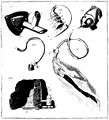 A primitive respirator was designed by Alexander von Humboldt in 1799 for underground mining
A primitive respirator was designed by Alexander von Humboldt in 1799 for underground mining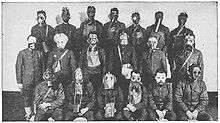 Various gas masks employed on the Western Front and Eastern Front during World War I
Various gas masks employed on the Western Front and Eastern Front during World War I Finnish civilian gas mask from 1939. These masks were distributed during World War II
Finnish civilian gas mask from 1939. These masks were distributed during World War II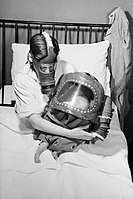 Mother and baby with gas masks, 1941
Mother and baby with gas masks, 1941
History and development
Early breathing devices
According to Popular Mechanics, "The common sponge was used in ancient Greece as a gas mask..."[9] In 1785, Jean-François Pilâtre de Rozier invented a respirator.
Primitive respirator examples were used by miners and introduced by Alexander von Humboldt already in 1799, when he worked as a mining engineer in Prussia.[10] The forerunner to the modern gas mask was invented in 1847 by Lewis P. Haslett, a device that contained elements that allowed breathing through a nose and mouthpiece, inhalation of air through a bulb-shaped filter, and a vent to exhale air back into the atmosphere.[11] According to First Facts, it states that the "gas mask resembling the modern type was patented by Lewis Phectic Haslett of Louisville, Kentucky who received a patent on June 12, 1849." [12] U.S. patent #6,529 issued to Haslett, described the first "Inhaler or Lung Protector" that filtered dust from the air.[13]
Early versions were constructed by the Scottish chemist John Stenhouse in 1854[14] and the physicist John Tyndall in the 1870s.[15] Another early design was the "Safety Hood and Smoke Protector" invented by Garrett Morgan in 1912, and patented in 1914. It was a simple device consisting of a cotton hood with two hoses which hung down to the floor, allowing the wearer to breathe the safer air found there. In addition, moist sponges were inserted at the end of the hoses in order to better filter the air. This was later modified to include its own air supply, leading to World War I era gas masks.[16][17][18][19]
First World War
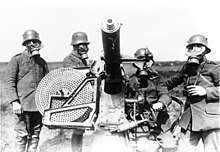
The First World War brought about the first need for mass-produced gas masks on both sides because of extensive use of chemical weapons. The German army successfully used poison gas for the first time against Allied troops at the Second Battle of Ypres, Belgium on 22 April 1915.[20] As an immediate response was cotton wool wrapped in muslin issued to the troops by 1 May. This was followed by the Black Veil Respirator, invented by John Scott Haldane, which was a cotton pad soaked in an absorbent solution which was secured over the mouth using black cotton veiling.[21]
Seeking to improve on the Black Veil respirator, Cluny MacPherson created a mask made of chemical absorbing fabric and which fitted over the entire head.[22] A 50.5 cm × 48 cm (19.9 in × 18.9 in) canvas hood treated with chlorine-absorbing chemicals, and fitted with a transparent mica eyepiece.[23] Macpherson presented his idea to the British War Office Anti-Gas Department on 10th of May 1915, with prototypes being developed soon after.[24] The design was adopted by the British Army and introduced as the British Smoke Hood in June 1915; Macpherson was appointed to the War Office Committee for Protection against Poisonous Gases.[25] More elaborate sorbent compounds were added later to further iterations of his helmet (PH helmet), to defeat other respiratory poison gases used such as phosgene, diphosgene and chloropicrin. In summer and autumn 1915, Edward Harrison, Bertram Lambert and John Sadd developed the Large Box Respirator.[26] This canister gas mask had a tin can containing the absorbent materials by a hose and began to be issued in February 1916. A compact version, the Small Box Respirator, was made a universal issue from August 1916.
In the first gas masks of World War I, it was initially found that wood charcoal was a good absorbent of poison gases. Around 1918, it was found that charcoals made from the shells and seeds of various fruits and nuts such as coconuts, chestnuts, horse-chestnuts, and peach stones performed much better than wood charcoal. These waste materials were collected from the public in recycling programs to assist the war effort.[27]
The first effective filtering activated charcoal gas mask in the world was invented in 1915 by Russian chemist Nikolay Zelinsky.[28]
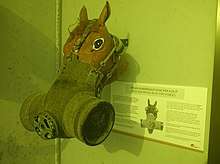
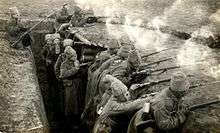
Also in World War I, since dogs were frequently used on the front lines, a special type of gas mask was developed that dogs were trained to wear.[29] Other gas masks were developed during World War I and the time following for horses in the various mounted units that operated near the front lines.[30] In America thousands of gas masks were produced for American as well as Allied troops. Mine Safety Appliances was a chief producer. This mask was later used widely in industry.[31]
Modern mask
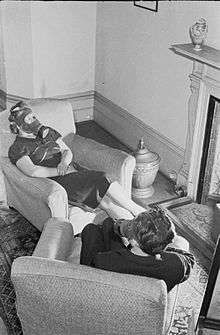
The British Respirator, Anti-Gas (Light) was developed in 1943 by the British.[32] It was made of plastic and rubber-like material that greatly reduced the weight and bulk, compared to World War I gas masks, and fitted the user's face more snugly and comfortably. The main improvement was replacing the separate filter canister connected with a hose by a filter canister screwed on the side of the gas mask, that could be replaced easily. Also, it had replaceable plastic lenses.
Gas mask development since has mirrored the development of chemical agents in warfare, filling the need to protect against ever more deadly threats, biological weapons, and radioactive dust in the nuclear era. However, for agents that cause harm through contact or penetration of the skin, such as blister agent or nerve agent, a gas mask alone is not sufficient protection, and full protective clothing must be worn in addition to protect from contact with the atmosphere. For reasons of civil defense and personal protection, individuals often buy gas masks since thry believe that they protect against the harmful effects of an attack with nuclear, biological, or chemical (NBC) agents, which is only partially true, as gas masks protect only against respiratory absorption. Most military gas masks are designed to be capable of protection against all NBC agents, but they can have filter canisters proof against those agents (heavier) or only against riot control agents and smoke (lighter and often used for training purposes); likewise, there are lightweight masks solely for use in riot control agents and not for NBC situations.
Although thorough training and the availability of gas masks and other protective equipment can nullify the casualty-causing effects of an attack by chemical agents, troops who are forced to operate in full protective gear are less efficient in completing tasks, tire easily, and may be affected psychologically by the threat of attack by those weapons. During the Cold War, it was seen as inevitable that there would be a constant NBC threat on the battlefield and so troops needed protection in which they could remain fully functional; thus, protective gear and especially gas masks have evolved to incorporate innovations in terms of increasing user comfort and in compatibility with other equipment (from drinking devices to artificial respiration tubes, to communications systems etc.). The gas mask has thus now arrived at a "fourth generation" of development.
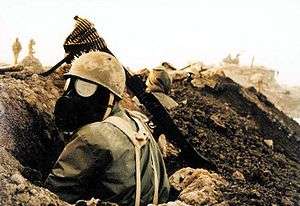
During the Iran–Iraq War (1980–88), Iraq developed its chemical weapons program with the help of European countries such as Germany and France and used them in a large scale against Iranians and Iraqi Kurds. Iran was unprepared for chemical warfare. In 1984, Iran received gas masks from the Republic of Korea and East Germany, but the Korean masks were not suited for the faces of non-East Asian people, the filter lasted for only 15 minutes, and the 5,000 masks bought from East Germany proved to be not gas masks but spray-painting goggles. As late as 1986, Iranian diplomats still traveled in Europe to buy active charcoal and models of filters to produce defensive gear domestically. In April 1988, Iran started domestic production of gas masks by the Iran Yasa factories.[33]
In schools
Most civilians learned how to use gas masks through the civil defense department, but children received most gas mask education in school drills. Schools would implement gas mask education and training after the outbreak of a war. Schools would harshly enforce the compulsory carrying of gas masks at all times. Gas mask and air raid drills were closely related and children would be made to wear gas masks in everyday activities, including gymnastics. The wearing of gas masks in the classrooms were especially difficult for teachers as they had trouble distinguishing one child from another. The gas masks became as uniform as the students' uniforms. Other civilians learned the use of a gas mask through posters, pamphlets, and radio lectures, but children learned through cartoons and rhymes such as "coughs and sneezes spread diseases".[34]
See also
- Assigned Protection Factors
- Cartridges and canisters of air-purifying respirators
- GP-5 gas mask
- Hopcalite
- M2 Gas Mask
- M40 Field Protective Mask
- M50 joint service general purpose mask
- C-4 Protective Mask
- NBC suit
- PH helmet
- Plague doctor's outfit
- Respirator
- Respirator fit test
- Respirators testing in the workplaces
- Respirator assigned protection factors
- Smoke hood
Notes
- Rumpf, Hans. Gasschutz.
- "Porton Down report on the presence of asbestos in World War II respirator canisters" (PDF). p. 2 (summary).
- Burns, Judith (2014-05-13). "Ban wartime gas masks, schools told". BBC News. Retrieved 2018-08-21.
- Dail, David H.; Hammar, Samuel P.; Colby, Thomas V. (2012-12-06). Pulmonary Pathology — Tumors. Springer Science & Business Media. ISBN 978-1-4612-2496-9.
- Acheson, E D; Gardner, M J; Pippard, E C; Grime, L P (1982). "Mortality of two groups of women who manufactured gas masks from chrysotile and crocidolite asbestos: a 40-year follow-up". Occupational and Environmental Medicine. 39 (4): 344–8. doi:10.1136/oem.39.4.344. PMC 1009064. PMID 6291580.
- "Guide for selection and use of filtering devices" (PDF). draeger.com. Archived from the original (PDF) on 2012-05-26. Retrieved 2013-02-22.
- "OSHA Bulletin: General Respiratory Protection Guidance for Employers and Workers". Occupational Safety and Health Administration.
- "Archived copy" (PDF). Archived from the original (PDF) on 2012-10-20. Retrieved 2010-07-09.CS1 maint: archived copy as title (link)
- "Popular Mechanics". January 1984. p. 163
- Von Humboldt, Alexander (1799). Ueber die unterirdischen Gasarten und die Mittel, ihren Nachtheil zu vermindern: Ein Beytrag zur Physik der praktischen Bergbaukunde. Braunschweig, Friedrich Vieweg.
- "The invention of the gas mask". Ian Taggart. Archived from the original on 2013-05-02.
- Drobnicki, John A.; Asaro, Richard (2001). "Historical Fabrications on the Internet". In Su, Di (ed.). Evolution in Reference and Information Services: The Impact of the Internet. Binghamton, New York: Haworth Information Press. p. 144. ISBN 978-0-7890-1723-9.
- "Lewis P". United States Patent and Trademark office.
- Alvin K. Benson (2010). Inventors and inventions. Salem Press. ISBN 978-1-58765-526-5.
- The Environment and Its Effect Upon Man: Symposium Held at Harvard School of Public Health, August 24-August 29, 1936, as Part of Harvard University Tercentenary Celebration, 1636-1936. Harvard School of Public Health. 1937.
- Jr, Henry Louis Gates; Higginbotham, Evelyn Brooks (2004-04-29). African American Lives. Oxford University Press. ISBN 9780199882861.
By World War I, Morgan had modified the mask to carry its own air supply, creating the first gas mask, which by 1917 was standard equipment for the U.S. Army.
- "Garrett Augustus Morgan". PBS Who Made America?.
He sold the hoods to the U.S. Navy, and the Army used them in World War I.
- "Morgan, Garrett 1877–1963". Encyclopedia.com Contemporary Black Biography.
Morgan would later perfect his “breathing device” into a gas mask that was used extensively in World War I.
- "Garrett Morgan Biography". Biography.com People.
Morgan's breathing device became the prototype and precursor for the gas masks used during World War I, protecting soldiers from toxic gas used in warfare.
- "Second Battle of Ypres Begins". history.com. Retrieved April 22, 2018.
- Wetherell & Mathers 2007, p. 157.
- Victor Lefebure (1923). The Riddle of the Rhine: Chemical Strategy in Peace and War. The Chemical Foundation Inc. ISBN 0-585-23269-5.
- "Macpherson Gas Hood . Accession #980.222". The Rooms Provincial Museum Archives (St. John’s, NL). Retrieved August 5, 2017.
- Mayer-Maguire & Baker 2015.
- "Biographical entry Macpherson, Cluny (1879 - 1966)". livesonline.rcseng.ac.uk. Retrieved April 22, 2018.
- "The UK". The Gas Mask Database.
- Once Worthless Things that have Suddenly Become of Value, Popular Science monthly, December 1918, page 80, scanned by Google Books
- Kozhevnikov, A B (2004). Stalin's great science: the times and adventures of Soviet physicists (illustrated, reprint ed.). Imperial College Press. pp. 10–11. ISBN 978-1-86094-419-2. Retrieved 2009-04-28.
- "Gas-Masks for Dogs / Dumb Heroes of the Fighting Front", Popular Science monthly, December 1918, page 75, Scanned by Google Books
- "Gas Masks to Guard Horses and Dogs in War" Popular Mechanics, July 1934, bottom pg. 75
- Pittsburgh Post-Gazette, November 30, 1960
- https://www.iwm.org.uk/collections/item/object/30016346
- Zanders, Jean Pascal (March 7, 2001). "Iranian Use of Chemical Weapons: A Critical Analysis of Past Allegations". CNS Briefings. James Martin Center for Nonproliferation Studies. Archived from the original on March 20, 2015. Retrieved 27 March 2016.
- "EBSCOhost Login". search.ebscohost.com. Retrieved 25 March 2018.
Bibliography
- Wetherell, Anthony; Mathers, George (2007), "Respiratory Protection", in Marrs, Timothy; Maynard, Robert; Sidell, Frederick (eds.), Chemical Warfare Agents: Toxicology and Treatment, New York: Wiley, pp. 157–174, ISBN 978-0470013595CS1 maint: ref=harv (link)
- Mayer-Maguire, Thomas; Baker, Brian (2015), British Military Respirators and Anti-Gas Equipment of the Two World Wars, CrowoodCS1 maint: ref=harv (link)
External links
| Wikimedia Commons has media related to Gas mask. |
- How Stuff Works - Gas Masks Science.com
- The History of Gas Masks inventors.about.com, About, Inc. updated August 6, 2016
- Respirator Fact Sheet
- CBRN SCBA NIOSH Approved Respirators List of NIOSH Approved CBRN SCBA respirators
